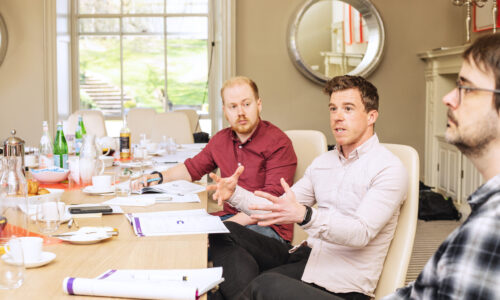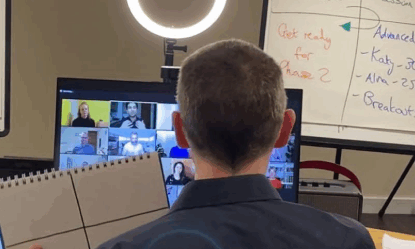“Handling objections well can improve your standing with your audience, give you valuable thinking time and allow you to understand the other person’s concerns more clearly.”
Dealing With Objections: 4 Key Steps To Better Conversations
It’s the situation most people in business dread.
You’re giving a presentation or chairing a meeting for which you’ve spent ages prepping. It’s all going according to plan until that tricky staff member puts up their hand and throws up an almighty objection.
Immediately, you feel put off your stride: you hadn’t factored in this viewpoint despite your meticulous planning. Your heart starts beating a little faster, you may feel defensive, and you want to do all that you can to get rid of this objection as quickly as possible to get back to your presentation.
While that might feel like the right thing to do, if you fail to deal with objections or difficult questions correctly, the longer-term impacts on your reputation can be worse than not getting through all your presentation material. Dismissing people’s objections or closing them down can lead to a lack of trust, a demotivated workforce or even a loss of business.
Learning how to handle objections well can improve your standing with your colleagues or audience. It can also give you valuable thinking time, allowing you to understand the other person’s concerns and process your response more clearly.
So, what can you do when you’re on the receiving end of an objection? Here are our four essential tips for having better, more productive and collaborative conversations.
Show empathy
Objections are primarily emotional responses and are often framed as a question.
“How do you expect us to work with even more clients per month when we’re already struggling to meet deadlines?”
You can hear the emotion in objections like this. It may be in the words the person uses, the tone of voice they adopt, and even in their body language, which may be defensive (think folded arms, an angry or sarcastic expression on their face).
Showing empathy to the person objecting is a way to diffuse some of the negative emotions surrounding their concern.
How to show empathy
- You can use your body language, gestures, and voice to demonstrate that you’re physically empathising with the other person.
- You might consider stepping back with one foot, using an open, palms up gesture to allow the other person to speak.
- You may want to tilt your head to the side slightly and soften your voice when you’re speaking.
It’s important to point out that showing empathy does not mean that you have to agree with the other person, but rather, it’s about seeing things from their point of view. And, as bestselling business author Annie McKee points out, you should never assume that you know what people are thinking and feeling. Instead, try to be curious…
Listen and ask questions
The Greek philosopher Epictetus wrote that ‘we have two ears and one mouth so that we can listen twice as much as we talk’ – and this is never truer than when dealing with objections.
When faced with an objection, there’s a real temptation to try and answer it straight away. We may panic and feel anxious, and our main concern is to close down the conversation as quickly as possible to get back on track with the main focus of the meeting or presentation.
However, doing this means that the person objecting may feel neglected or not listened to, which is ultimately demotivating and could negatively impact your reputation.
Instead, we need to shift our mindset from one of speaking to one of listening, with the other person doing around 80% of the talking.
Getting the other person talking
When an objection comes in, we suggest asking lots of open questions to encourage the other person to talk as much as possible.
This serves several purposes. First and foremost, it allows the person who has raised the question to get everything off their chest and feel heard, an essential part of dealing with the emotional aspect of objections.
Secondly, it will give you better clarity and understanding of the person’s problem, which, in turn, will help you to empathise more.
Finally, it will give you valuable thinking time, during which you can come up with solutions that you can propose later in the conversation.
How to ask open questions
Open questions don’t have a simple ‘yes’ or ‘no’ answer and require the other person to give a more detailed response.
A simple way to ask an open-ended question is to use sentences that include ‘tell’, ‘explain’ or ‘describe’. For example:
‘Tell me more about that?’
‘Explain the current challenges your department is facing?’
‘Describe what a typical workday is like?’.
Asking the right questions can open the conversation between you and the person objecting, and it’s something that can be practised in any part of your life, as life coach Amber L. Wright describes beautifully in her TED Talk. She believes that asking better questions is an investment in one of life’s greatest currencies: relationships.
Offer your response as a proposal
Once you’ve given the other person time to outline their concerns and asked lots of questions to clarify the situation, you may feel ready to offer your solution in response – but beware. This could undo all of your excellent work so far.
Giving a solution as a fait accompli can sometimes reignite the negative emotions of the person objecting. If they feel that you’re telling them what will happen, they may feel belittled and powerless.
Instead, by giving your response as a proposal, you can make the other person feel empowered, heard and ultimately move towards a situation of real collaboration.
The best way to propose your response is by offering it up as a question, starting with the words ‘So if…?’.
“So, if we were to extend your team’s deadline by a fortnight, would that work for you?”.
Questions give the other person a choice to say yes or no, which is much more empowering – and is a technique often followed by hostage negotiators. If the person rejects your proposal, you can continue to probe and ask further questions (whilst empathising with the other person) to try and come up with a mutually agreeable solution.
Do a final check
This is an essential part of dealing with objections, as it will allow you to close the conversation whilst making sure that the other person is happy with the resolution.
It will not only provide clarity to everyone in the room about what the solution is, but it will also give you a final opportunity to listen out for any further objections or negative emotions.
Simple questions like “So would that work for you?” or “Were there any other challenges surrounding this that you’d like to raise here?” will allow the other person to say whether they’re happy or not.
A word of caution, though. Sometimes people may say, “Yeah, that’s fine,” but you may hear through their tone of voice or their body language that it’s not fine at all! If you detect that an objection is still lingering, go back and ask further questions to triple check.
Dealing with conflict at work can be challenging and does take practice, but if you empathise with the other person and encourage them to speak as much as possible, you will soon be on your way to a mutually beneficial outcome – and ultimately, better work relationships.
If you would like to know more about how we can deliver bespoke conflict resolution training for your business, please contact the team today.


















